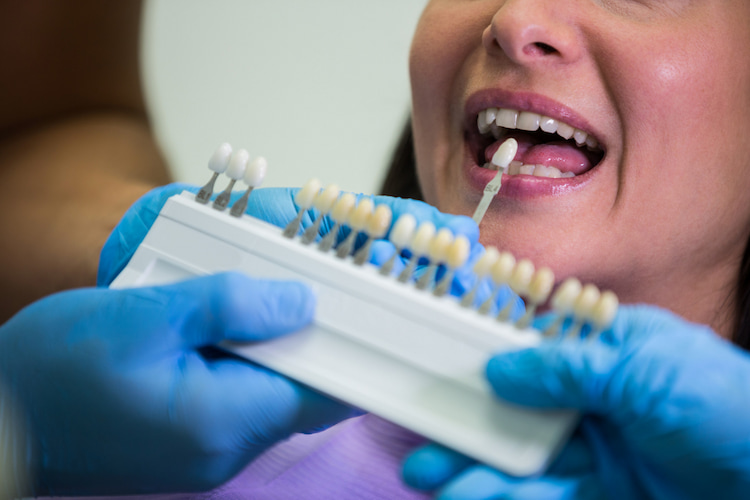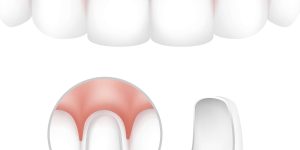If you’ve ever dreamed of having a perfect, radiant smile, dental veneers might be the solution you’re looking for. These thin, custom-made shells are placed over your natural teeth to address a variety of dental imperfections. Veneers have become increasingly popular due to their ability to enhance the aesthetics of your smile, and in this guide, we’ll explore everything from the procedure to the costs, benefits, and maintenance of veneers.
What Are Dental Veneers?
Dental veneers are ultra-thin shells that are custom-made to cover the front surface of your teeth. These shells are typically made from either porcelain or composite materials and are bonded to the tooth, allowing for a smooth and natural look. Veneers can be used to address a variety of cosmetic issues like chipped teeth, uneven spacing, or discoloration, providing a solution that enhances both function and appearance.
Types of Veneers: Porcelain vs. Composite
According to Healthline, When it comes to dental veneers, there are two main options: porcelain and composite. Each has its own set of benefits and drawbacks, and choosing the right one depends on your needs, budget, and desired results.
Porcelain Veneers
Porcelain veneers are the most popular choice for many patients because they are durable, natural-looking, and stain-resistant. The material is designed to mimic the translucence of your natural teeth, giving you a more lifelike appearance. They are particularly effective for correcting issues like chipped teeth, severe staining, or slight misalignment. However, because porcelain veneers require a more extensive procedure, they typically take a few visits to complete.
Composite Veneers
Composite veneers are made from a tooth-colored resin that is applied directly to your teeth, sculpted into shape, and then hardened using a special light. The biggest advantage of composite veneers is that they are more affordable and can be done in a single visit, making them a quicker solution for people looking for immediate results. However, they don’t have the same level of durability or natural appearance as porcelain veneers and may need to be replaced sooner.
Here you can compare your two options to decide which one is the best for you.
| Feature | Porcelain Veneers | Composite Veneers |
| Durability | Highly durable and long-lasting | Less durable, may need replacement |
| Aesthetic | Mimics natural teeth more closely | Less natural appearance, may discolor |
| Stain Resistance | Resistant to staining | More prone to staining over time |
| Cost | Expensive | More affordable |
| Procedure Time | Multiple visits (2-3) | Completed in one visit |
| Lifespan | 10-15 years | 5-7 years |
| Repairability | Harder to repair if damaged | Easier to repair if damaged |

What Dental Problems Do Veneers Treat?
Veneers are a versatile solution for a wide range of cosmetic dental issues. They can correct problems such as:
- Chipped or cracked teeth
- Gaps between teeth
- Misalignment
- Severe staining that doesn’t respond to traditional teeth whitening
Essentially, veneers give you the opportunity to transform your smile into something that’s both natural and stunning.
The Dental Veneer Procedure
Getting dental veneers involves several steps, but don’t worry, your dentist will guide you through the entire process.
- The first step: consultation
Your dentist will assess your teeth and discuss your goals for your smile.
- The 2nd step: preparing your teeth
This usually requires the removal of a small amount of enamel from the front of your teeth to ensure the veneers fit seamlessly.
- The 3rd step: create the veneers
Your dentist will take impressions of your teeth to create custom veneers.
- The last step: bond the veneers
Once your veneers are ready, your dentist will bond them to your teeth using a special adhesive, and you’ll leave the office with a brand-new smile.
The entire process typically takes two to three appointments, but the results are well worth the wait.

Tips for Aftercare and Maintenance for Veneers
While veneer aftercare is relatively simple, there are a few things to keep in mind to ensure they last. Avoid biting into hard objects like ice or pens, and be mindful of what you eat. While porcelain veneers are stain-resistant, it’s still a good idea to limit the consumption of staining foods and beverages like coffee, tea, and red wine. Regular brushing and flossing, along with routine dental checkups, will help maintain the longevity and appearance of your veneers.
Ready to Transform Your Smile?
At Pearl Dental Group, we specialize in creating beautiful, custom veneers that will give you the smile of your dreams. Contact us today to schedule your consultation and take the first step towards a more confident, radiant smile!
What Are the Top Benefits of Dental Veneers?
Dental veneers aren’t just about improving your smile. In fact, there are many pros and cons to veneers. They offer a number of practical benefits as well.
1. Aesthetic Improvements: Perfecting Your Smile
The main draw of dental veneers is their ability to enhance your smile. Whether you have chipped teeth, a slight misalignment, or discoloration, veneers provide a flawless, uniform look. They can be customized to match the color and shape of your natural teeth, ensuring a smile that’s as unique as you are.
2. Durability and Long-Lasting Results
Veneers, especially porcelain veneers, are highly durable and can last anywhere from 10 to 15 years with proper care. They’re resistant to staining and wear, which means you’ll be able to enjoy a beautiful, natural-looking smile for years to come. The longevity of veneers makes them a great investment in your smile makeover.
3. How Veneers Can Boost Your Confidence
Having a perfect smile can boost your confidence in both professional and personal settings. Dental veneers can transform your self-esteem, helping you smile without hesitation. We’ve seen so many patients walk out of here with a whole new level of confidence after getting veneers. One that stands out to us is a patient who had been covering her smile for years. After her veneers were done, she couldn’t stop grinning. She told us she finally felt like herself, and honestly, moments like that never get old.
What Is the Average Cost of Veneers?
Let’s cut to the chase: veneers aren’t cheap, but they’re worth every penny if you’re serious about transforming your smile. The price of veneers depends on a few things, like whether you go for porcelain (fancy, durable, natural-looking) or composite (more budget-friendly but needs touch-ups sooner). The price of veneers varies between 300 to 800 dollars.
It’s kind of an investment, but think about it this way:
You’re not just fixing your teeth; you’re giving yourself confidence that lasts years, sometimes over a decade, if you go porcelain and take care of them. Plus, most dentists offer financing options, so it doesn’t have to feel like you’re buying a car.
So, is it pricey? Sure. But ask anyone who’s had veneers, and they’ll tell you, it’s a game-changer.
Everything About Insurance Coverage for Veneers
In most cases, cosmetic dentistry treatments like veneers are not covered by insurance. However, some patients may be able to get partial coverage if their veneers are used to restore a broken or damaged tooth. It’s important to check with your insurance provider to understand what’s covered under your plan.
Are You the Ideal Candidate for Veneers?
While veneers are a great option for many people, not everyone is a perfect candidate. Ideal candidates are those who have healthy teeth but are looking to address cosmetic issues like chips, gaps, or discoloration. However, if you have serious dental issues such as gum disease or tooth decay, your dentist may recommend treating those problems before proceeding with veneers.
What Are the Alternative Treatments to Veneers?
If veneers aren’t your thing, don’t worry; there are other smile-enhancing options to consider. Here’s a list of your alternatives:
1. Tooth Bonding
A tooth-colored resin is applied and shaped to blend seamlessly with your teeth. It’s quick and non-invasive.
2. Teeth Whitening
While it doesn’t address chips or gaps, it’s a fast and effective way to brighten your smile, perfect for those who just want to refresh their look.
3. Orthodontic Treatments (Braces or Clear Aligners)
For gaps, misaligned teeth, or bite issues, orthodontic solutions like braces or clear aligners (e.g., Invisalign) might be the way to go. It’s a longer process, but the results can be transformative.
4. Dental Crowns
They cover the entire tooth, providing both strength and aesthetics. Crowns are ideal for teeth that need more than a cosmetic touch-up.
5. Snap-On Smiles
While it’s not a long-term solution, it’s perfect for special occasions or testing out the look of veneers without the commitment.
6. No-Prep Veneers
They’re thinner and more natural-looking but might not work for everyone, depending on your dental needs.
| Treatment Option | Pros | Cons | Cost (Approx.) | Recovery/Procedure Time |
| Tooth Bonding | Budget-friendly; quick and non-invasive; natural look | Not as durable as veneers; lasts 5–10 years with care | $100–$400 per tooth | 30 minutes to 1 hour per tooth |
| Teeth Whitening | Brightens teeth effectively; fast results | Doesn’t fix chips or gaps; requires maintenance over time | $300–$600 per session | 1–2 hours per session |
| Orthodontic Treatments | Corrects misaligned teeth, gaps, and bite issues | Long process; requires commitment | $3,000–$8,000 total | Months to years (depending on case complexity) |
| Dental Crowns | Comprehensive solution for severe damage; durable | Invasive; requires tooth reshaping; higher cost | $800–$2,500 per crown | 2 visits; 1–2 weeks for permanent crown placement |
| Snap-On Smiles | Temporary, removable, and non-invasive | Not a long-term solution; less durable | $1,000–$3,500 total | Instant after fitting; no downtime |
| No-Prep Veneers | Minimally invasive; natural-looking | Limited to specific cases; may not work for severe issues | $800–$2,000 per tooth | 2 visits; minimal downtime |
Your dentist will help you figure out what’s best for your goals, budget, and smile.
At Pearl Dental Group, we offer top-quality dental veneer treatment. Please contact us and let us know how we can help!
FAQs
-
Do veneers look natural? Will people notice them?
Veneers are designed to look like natural teeth, matching the color and shape for a seamless appearance. Most people won’t notice unless you tell them.
-
Are dental veneers painful to get?
The procedure is generally not painful, as dentists use local anesthesia if needed. Some patients may experience mild sensitivity afterward.
-
How long do dental veneers last?
Porcelain veneers typically last 10–15 years, while composite veneers may last 5–7 years with proper care. Longevity depends on maintenance and habits.
-
Are porcelain or composite veneers better for me?
Porcelain veneers are more durable and stain-resistant, while composite veneers are more affordable and quicker to apply. Your dentist can recommend the best option based on your needs and budget.
-
Do I need to prepare my teeth before getting veneers?
Yes, some enamel is typically removed to ensure the veneers fit properly and look natural. However, for those looking for a less invasive option, minimal-prep or no-prep veneers are available, which require little to no enamel removal. Your dentist will guide you on the best approach based on your individual needs.
-
Do veneers stain or discolor over time?
Porcelain veneers are highly stain-resistant, while composite veneers can stain over time. Regular care helps maintain their appearance.









